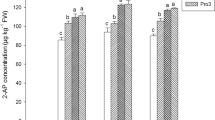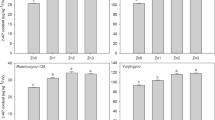Abstract
Pot experiments were conducted to investigate the physiological and biochemical effect of exogenous MG application on two fragrant rice cultivars, Meixiangzhan and Yuxiangyouzhan. The MG application included four treatments: 1 mmol·L–1 (MG1), 5 mmol·L–1 (MG5), and 10 mmol·L–1 (MG10), and deionized water as control (MG0). Results indicated that MG1 significantly increased the yield by 11.54–14.06% through promoting the seed-setting rate. Increases on grain 2-acetyl-1-pyrroline (2-AP) content at maturity were found in MG1. The contents of proline, Δ1-pyrrolin-5-carboxylic acid (P5C), pyrroline, and MG, and the activities of proline dehydrogenase (PDH), ornithine aminotransferase (OAT), and Δ1-pyrrolin-5-carboxylate synthase (P5CS) in plant tissues at all sampling stage were also increased in MG1 than MG0. In addition, although the malondialdehyde (MDA) content at all sampling stage was increased by MG application, MG1 increased the antioxidant enzyme activities and soluble protein content in all plant tissues and the pigment content in leaves. However, high-level MG (10 mmol·L–1) application significantly decreased the yield and grain 2-AP content. Overall, this study suggested that exogenous MG application regulated the 2-AP accumulation, yield formation, and antioxidant attributes in fragrant rice, and that MG application at the concentration of 1 mmol·L–1 increased the 2-AP content.







Similar content being viewed by others
Abbreviations
- MG:
-
Methylglyoxal
- MG0:
-
Spraying deionized water
- MG1:
-
Spraying 1 mmol·L–1 MG
- MG5:
-
Spraying 5 mmol·L–1 MG
- MG10:
-
Spraying 10 mmol·L–1 MG
- 2-AP:
-
2-Acetyl-1-pyrroline
- PDH:
-
Proline dehydrogenase
- OAT:
-
Ornithine aminotransferase
- P5CS:
-
Δ1-Pyrrolin-5-carboxylate synthase
- P5C:
-
Δ1-Pyrrolin-5-carboxylic acid
- DAO:
-
Diamine oxidase
- GABald:
-
γ-Aminobutyraldehyde
- GABA:
-
γ-Aminobutyric acid
- BADH:
-
Betaine aldehyde dehydrogenase
- AS:
-
After spraying
- MS:
-
Maturity sage
- ADW:
-
Above-ground dry weight
- FW:
-
Fresh weight
- MDA:
-
Malondialdehyde
- SOD:
-
Superoxide dismutase
- POD:
-
Peroxidase
- CAT:
-
Catalase
- ROS:
-
Reactive oxygen species
References
Ashraf U, Kanu AS, Deng QQ (2017) Lead (Pb) toxicity; physio-biochemical mechanisms, grain yield, quality, and Pb distribution proportions in scented rice. Front Plant Sci 8(259):1–17
Gross BL, Zhao Z (2014) Archaeological and genetic insights into the origins of domesticated rice. Proc Natl Acad Sci 111(17):6190–6197
Banerjee A, Roychoudhury A, Ghosh P (2019) Differential fluoride uptake induces variable physiological damage in a non-aromatic and an aromatic indica rice cultivar. Plant Physiol Biochem 142:143–150
Banu MNA, Hoque MA, Watanabe-Sugimoto M (2010) Proline and glycinebetaine ameliorated NaCl stress via scavenging of hydrogen peroxide and methylglyoxal but not superoxide or nitric oxide in tobacco cultured cells. Biosci Biotechnol Biochem 10:2043–2049
Bradbury LMT, Gillies SA, Brushett DJ (2008) Inactivation of an aminoaldehyde dehydrogenase is responsible for fragrance in rice. Plant Mol Biol 68(4):439–449
Buttery RG, Ling LC, Juliano BO (1983) Cooked rice aroma and 2-acetyl-1-pyrroline. J Agric Food Chem 31(4):823–826
Gao Z, Xie W, Ashraf U (2020) Exogenous γ-aminobutyric acid (GABA) application at different growth stages regulates 2-acetyl-1-pyrroline, yield, quality and antioxidant attributes in fragrant rice. J Plant Interact 15(1):139–152
Gu J, Zhou Z, Li Z (2016) Effects of the mutant with low chlorophyll content on photosynthesis and yield in rice. Acta Agron Sin 42(4):551–560 ((In Chinese with English abstract))
Hoque MA, Uraji M, Torii A (2012) Methylglyoxal inhibition of cytosolic ascorbate peroxidase from Nicotiana tabacum. J Biochem Mol Toxicol 26(8):315–321
Hoque TS, Hossain MA, Mostofa MG (2015) Signalling roles of methylglyoxal and the involvement of the glyoxalase system in plant abiotic stress responses and tolerance. In: Azooz MM, Ahmad P (eds) Plant-environment interaction: responses and approaches to mitigate stress. Wiley, Chichester, pp 311–326
Hoque TS, Hossain MA, Mostofa MG (2016) Methylglyoxal: an emerging signaling molecule in plant abiotic stress responses and tolerance. Front Plant Sci 7:1341
Huang TC, Teng CS, Chang JL (2008) Biosynthetic mechanism of 2-acetyl-1-pyrroline and its relationship with Δ1-pyrroline-5-carboxylic acid and methylglyoxal in aromatic rice (Oryza sativa L.) callus. J Agric Food Chem 56(16):7399–7404
Imran M, Hussain S, El-Esawi MA (2020) Molybdenum supply alleviates the cadmium toxicity in fragrant rice by modulating oxidative stress and antioxidant gene expression. Biomolecules 10(11):1582
Li M, Ashraf U, Tian H (2016) Manganese-induced regulations in growth, yield formation, quality characters, rice aroma and enzyme involved in 2-acetyl-1-pyrroline biosynthesis in fragrant rice. Plant Physiol Biochem 103:167–175
Li Y, Mo Z, Li Y (2021) Additional nitrogen application under different water regimes at tillering stage enhanced rice yield and 2-acetyl-1-pyrroline (2-ap) content in fragrant rice. J Plant Growth Regul 1:1–11
Li ZG (2016) Methylglyoxal and glyoxalase system in plants: old players, new concepts. Bot Rev 82(2):183–203
Luo H, Du B, He L (2019) Exogenous application of zinc (Zn) at the heading stage regulates 2-acetyl-1-pyrroline (2-AP) biosynthesis in different fragrant rice genotypes. Sci Rep 9(1):1–10
Luo H, Xing PP, Liu JH (2020a) Application of ornithine-induced regulation in yield formation, grain quality and aroma of fragrant rice. Cereal Res Commun 48(4):485–492
Luo H, Zhang T, Zheng A (2020) Exogenous proline induces regulation in 2-acetyl-1-pyrroline (2-AP) biosynthesis and quality characters in fragrant rice (Oryza sativa L.). Sci Rep 10(1):1–8
Luo H, He L, Du B (2020) Biofortification with chelating selenium in fragrant rice: Effects on photosynthetic rates, aroma, grain quality and yield formation. Field Crops Res 255:107909
Mano J, Miyatake F, Hiraoka E (2009) Evaluation of the toxicity of stress-related aldehydes to photosynthesis in chloroplasts. Planta 230(4):639–648
Mir MA, John R, Alyemeni MN (2018) Jasmonic acid ameliorates alkaline stress by improving growth performance, ascorbate glutathione cycle and glyoxylase system in maize seedlings. Sci Rep 8(1):1–13
Mo Z, Li Y, Nie J (2019) Nitrogen application and different water regimes at booting stage improved yield and 2-acetyl-1-pyrroline (2AP) formation in fragrant rice. Rice 12(1):1–16
Mo Z, Li W, Pan S (2015) Shading during the grain filling period increases 2-acetyl-1-pyrroline content in fragrant rice. Rice 8(1):1–10
Nahar K, Hasanuzzaman M, Alam MM (2015a) Roles of exogenous glutathione in antioxidant defense system and methylglyoxal detoxification during salt stress in mung bean. Biol Plant 59(4):745–756
Nahar K, Hasanuzzaman M, Alam MM (2015) Glutathione-induced drought stress tolerance in mung bean: coordinated roles of the antioxidant defense and methylglyoxal detoxification systems. AoB Plants 7:plv069
Rahman A, Mostofa MG, Nahar K (2016) Exogenous calcium alleviates cadmium-induced oxidative stress in rice (Oryza sativa L.) seedlings by regulating the antioxidant defense and glyoxalase systems. Brazil J Bot 39(2):393–407
Ren Y, Ashraf U, He LX (2017) Irrigation and nitrogen management practices affect grain yield and 2-acetyl-1-pyrroline content in aromatic rice. Appl Ecol Environ Res 15(4):1447–1460
Sakthivel K, Sundaram RM, Rani NS (2009) Genetic and molecular basis of fragrance in rice. Biotechnol Adv 27(4):468–473
Savicka M, Škute N (2010) Effects of high temperature on malondialdehyde content, superoxide production and growth changes in wheat seedlings (Triticum aestivum L.). Ekologija 56(1):26–33
Verma DK, Thakur M, Srivastav PP (2020) Biochemistry and molecular aspects of 2-acetyl-1-pyrroline biosynthesis in rice (Oryza sativa L.): A review. Israel J Plant Sci 67(3–4):129–143
Xie H, Xie W, Pan S (2021) Effects of light quality treatments during the grain filling period on yield, quality, and fragrance in fragrant rice. Agronomy 11(3):531
Xie W, Kong L, Ma L (2020) Enhancement of 2-acetyl-1-pyrroline (2AP) concentration, total yield, and quality in fragrant rice through exogenous γ-aminobutyric acid (GABA) application. J Cereal Sci 91:102900
Acknowledgements
The authors would like to thank TopEdit (www.topeditsci.com) for its linguistic assistance during the preparation of this manuscript.
Funding
We acknowledge the funding provided by Research Start-up Fund for High-level Talents of Yulin Normal University (G2019ZK41 and G2019ZK42), Natural Science Foundation of Guangxi (2021GXNSFBA196084), College Students Innovation and Entrepreneurship Training Program (202010606045 and 202110606160).
Author information
Authors and Affiliations
Contributions
SC is a faculty member of the College of Biology and Pharmacy, Yulin Normal University. Her main works include the research on crop production and physiology of fragrant rice. ZF is a faculty member of the College of Biology and Pharmacy, Yulin Normal University. His main works include the research on heavy metal toxicity. CW is a custom officer of the Hefei Customs District. His man works include the research on food chemistry and chemical composition analysis. XC is an undergraduate student of horticulture, College of Biology and Pharmacy, Yulin Normal University. FH is an undergraduate student of Landscape Architecture, College of Biology and Pharmacy, Yulin Normal University. CY is an undergraduate student of horticulture, College of Biology and Pharmacy, Yulin Normal University. LZ is an undergraduate student of horticulture, College of Biology and Pharmacy, Yulin Normal University. XW is an undergraduate student of horticulture, College of Biology and Pharmacy, Yulin Normal University. ZL is an undergraduate student of horticulture, College of Biology and Pharmacy, Yulin Normal University. YR is a faculty member of the College of Biology and Pharmacy, Yulin Normal University. His main works include the research on crop production and physiology of fragrant rice.
Corresponding author
Ethics declarations
Competing interest
No conflict of interest exists among author(s).
Additional information
Handling Editor: Mikihisa Umehara.
Publisher's Note
Springer Nature remains neutral with regard to jurisdictional claims in published maps and institutional affiliations.
Supplementary Information
Below is the link to the electronic supplementary material.
Rights and permissions
About this article
Cite this article
Cheng, S., Fang, Z., Wang, C. et al. Modulation of 2-Acetyl-1-pyrroline (2-AP) Accumulation, Yield Formation and Antioxidant Attributes in Fragrant Rice by Exogenous Methylglyoxal (MG) Application. J Plant Growth Regul 42, 1444–1456 (2023). https://doi.org/10.1007/s00344-022-10628-y
Received:
Accepted:
Published:
Issue Date:
DOI: https://doi.org/10.1007/s00344-022-10628-y




